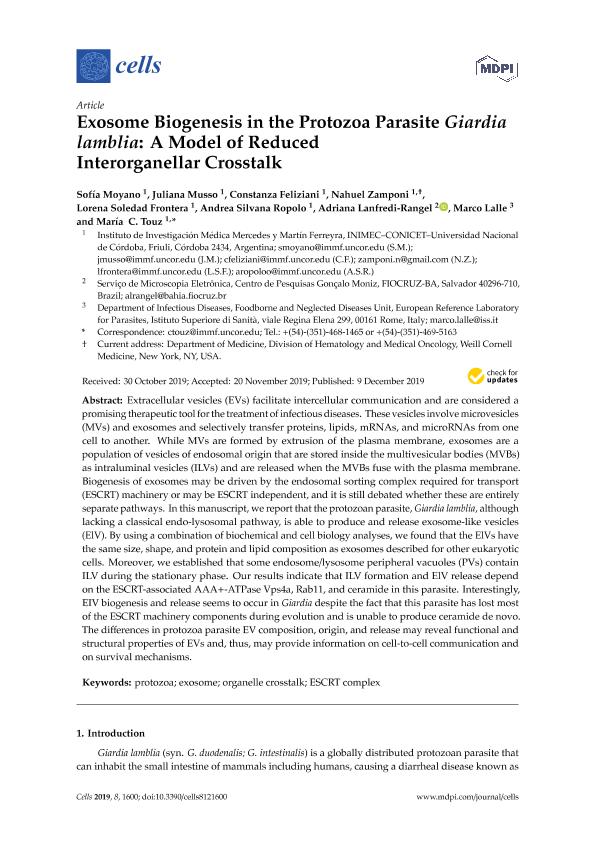Artículo
Exosome biogenesis in the protozoa parasite Giardia lamblia: A model of reduced interorganellar crosstalk
Moyano, Sofia ; Musso, Juliana Rita; Feliziani, Constanza
; Musso, Juliana Rita; Feliziani, Constanza ; Zamponi, Nahuel
; Zamponi, Nahuel ; Frontera, Lorena Soledad
; Frontera, Lorena Soledad ; Ropolo, Andrea Silvana
; Ropolo, Andrea Silvana ; Lanfredi-Rangel, Adriana; Lalle, Marco; Touz, Maria Carolina
; Lanfredi-Rangel, Adriana; Lalle, Marco; Touz, Maria Carolina
 ; Musso, Juliana Rita; Feliziani, Constanza
; Musso, Juliana Rita; Feliziani, Constanza ; Zamponi, Nahuel
; Zamponi, Nahuel ; Frontera, Lorena Soledad
; Frontera, Lorena Soledad ; Ropolo, Andrea Silvana
; Ropolo, Andrea Silvana ; Lanfredi-Rangel, Adriana; Lalle, Marco; Touz, Maria Carolina
; Lanfredi-Rangel, Adriana; Lalle, Marco; Touz, Maria Carolina
Fecha de publicación:
12/2019
Editorial:
NLM (Medline)
Revista:
Cells
e-ISSN:
2073-4409
Idioma:
Inglés
Tipo de recurso:
Artículo publicado
Clasificación temática:
Resumen
Extracellular vesicles (EVs) facilitate intercellular communication and are considered a promising therapeutic tool for the treatment of infectious diseases. These vesicles involve microvesicles (MVs) and exosomes and selectively transfer proteins, lipids, mRNAs, and microRNAs from one cell to another. While MVs are formed by extrusion of the plasma membrane, exosomes are a population of vesicles of endosomal origin that are stored inside the multivesicular bodies (MVBs) as intraluminal vesicles (ILVs) and are released when the MVBs fuse with the plasma membrane. Biogenesis of exosomes may be driven by the endosomal sorting complex required for transport (ESCRT) machinery or may be ESCRT independent, and it is still debated whether these are entirely separate pathways. In this manuscript, we report that the protozoan parasite, Giardia lamblia, although lacking a classical endo-lysosomal pathway, is able to produce and release exosome-like vesicles (ElV). By using a combination of biochemical and cell biology analyses, we found that the ElVs have the same size, shape, and protein and lipid composition as exosomes described for other eukaryotic cells. Moreover, we established that some endosome/lysosome peripheral vacuoles (PVs) contain ILV during the stationary phase. Our results indicate that ILV formation and ElV release depend on the ESCRT-associated AAA+-ATPase Vps4a, Rab11, and ceramide in this parasite. Interestingly, EIV biogenesis and release seems to occur in Giardia despite the fact that this parasite has lost most of the ESCRT machinery components during evolution and is unable to produce ceramide de novo. The differences in protozoa parasite EV composition, origin, and release may reveal functional and structural properties of EVs and, thus, may provide information on cell-to-cell communication and on survival mechanisms.
Palabras clave:
ESCRT COMPLEX
,
EXOSOME
,
ORGANELLE CROSSTALK
,
PROTOZOA
Archivos asociados
Licencia
Identificadores
Colecciones
Articulos(INIMEC - CONICET)
Articulos de INSTITUTO DE INV. MEDICAS MERCEDES Y MARTIN FERREYRA
Articulos de INSTITUTO DE INV. MEDICAS MERCEDES Y MARTIN FERREYRA
Citación
Moyano, Sofia; Musso, Juliana Rita; Feliziani, Constanza; Zamponi, Nahuel; Frontera, Lorena Soledad; et al.; Exosome biogenesis in the protozoa parasite Giardia lamblia: A model of reduced interorganellar crosstalk; NLM (Medline); Cells; 8; 12; 12-2019; 1-19
Compartir
Altmétricas



